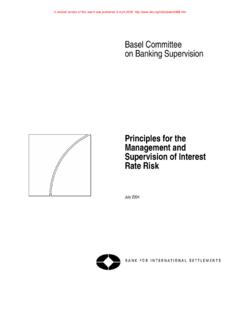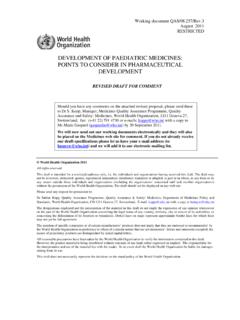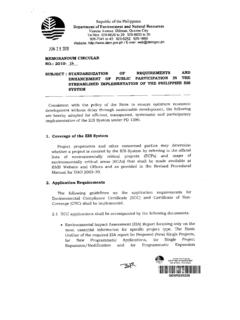Transcription of STABILITY TESTING OF ACTIVE PHARMACEUTICAL …
1 Working document January 2017. Draft document for comment 1 STABILITY TESTING OF ACTIVE . 2 PHARMACEUTICAL ingredients AND. 3 finished PHARMACEUTICAL PRODUCTS. 4 (January 2017). 5 DRAFT FOR COMMENT. Should you have any comments on the attached text and the STABILITY conditions for WHO Member States (MS) by Region, appendixed to the previous version of this guidance ( ), please send these to: Dr Sabine Kopp, Group Lead, Medicines Quality Assurance, Technologies Standards and Norms, World Health Organization, 1211 Geneva 27, Switzerland; email: fax: (+41 22) 791 4730;. and to Mrs Ksenia Finnerty by 15 March 2017.
2 In line with the recommendations of the WHO Expert Committee on Specifications for PHARMACEUTICAL Preparations the list of MS STABILITY conditions is maintained as a living document. Comments received after the indicated date will also be considered. Working documents are sent out electronically and they will also be placed on the Medicines website for comment. If you do not already receive directly our draft guidelines please let us have your email address (to and we will add it to our electronic mailing list. 6. 7 World Health Organization 2017. 8 All rights reserved. 9 . is intended for a restricted audience only, the individuals and organizations having received this draft.)
3 This draft 10 The draft may not be reviewed, abstracted, quoted, reproduced, transmitted, distributed, translated or adapted, in 11 part or in whole, in any form or by any means outside these individuals and organizations (including the 12 organizations' concerned staff and member organizations) without the permission of the World Health Organization. 13 The draft should not be displayed on any website. 14 Please send any request for permission to: 15 Dr Sabine Kopp, Group Lead, Medicines Quality Assurance, Technologies Standards and Norms, Department of 16 Essential Medicines and Health Products, World Health Organization, CH-1211 Geneva 27, Switzerland.
4 17 Fax: (41-22) 791 4730; email: 18 The designations employed and the presentation of the material in this draft do not imply the expression of any 19 opinion whatsoever on the part of the World Health Organization concerning the legal status of any country, 20 territory, city or area or of its authorities, or concerning the delimitation of its frontiers or boundaries. Dotted lines 21 on maps represent approximate border lines for which there may not yet be full agreement. 22 The mention of specific companies or of certain manufacturers' products does not imply that they are endorsed or 23 recommended by the World Health Organization in preference to others of a similar nature that are not mentioned.
5 24 Errors and omissions excepted, the names of proprietary products are distinguished by initial capital letters. 25 All reasonable precautions have been taken by the World Health Organization to verify the information contained in 26 this draft. However, the printed material is being distributed without warranty of any kind, either expressed or 27 implied. The responsibility for the interpretation and use of the material lies with the reader. In no event shall the 28 World Health Organization be liable for damages arising from its use. 29 This draft does not necessarily represent the decisions or the stated policy of the World Health Organization.
6 Working document page 2. 30 SCHEDULE FOR THE PROPOSED ADOPTION PROCESS OF DOCUMENT. 31 : 32 STABILITY TESTING OF ACTIVE PHARMACEUTICAL ingredients . 33 AND finished PHARMACEUTICAL PRODUCTS. 34. Development of the proposal to update the guideline for June 2016. STABILITY TESTING of ACTIVE PHARMACEUTICAL ingredients and finished PHARMACEUTICAL products (TRS 953, Annex 2, 2009). Presentation of the proposal to the joint meeting on July 2016. regulatory guidance for multisource products with the medicines quality assurance group and the WHO. Prequalification Team Medicines (PQTm) and with regulatory experts Presentation of the proposal to the fifty-first meeting of October 2016.
7 The WHO Expert Committee on Specifications for PHARMACEUTICAL Preparations (ECSPP). Development of the draft guideline and preparation of September . December 2016. revised text by Mrs Lynda Paleshnuik, Canada Mailing and posting of the working document on the January 2017. WHO website for public consultation as recommended by the WHO ECSPP. Compilation of comments received April 2017. Discussion of feedback received during an informal Date tbd consultation Circulation for comments August 2017. Compilation of comments received September 2017. Presentation to fifty-second meeting of the WHO ECSPP October 2017.
8 Further follow-up action as required . 35. Working document page 3. 36 Introduction and background 37. 38 The STABILITY TESTING of ACTIVE PHARMACEUTICAL ingredients and finished 39 PHARMACEUTICAL products was published as Annex 2 in the WHO Technical 40 Report Series, No. 953, 2009 (1). 41. 42 These regulatory guidelines seek to exemplify the core STABILITY data package 43 required for registration of ACTIVE PHARMACEUTICAL ingredients (APIs) and finished 44 PHARMACEUTICAL products (FPPs), replacing the previous WHO guidelines in this 45 area. The guidelines cross-reference to the series of related International Council 46 on Harmonisation (ICH) guidelines (2) and other WHO guidelines.
9 47. 48 It was recommended at the time of publication that these guidelines should also 49 be applied to products that are already being marketed, with allowance for an 50 appropriate transition period, upon re-registration or upon re-evaluation. 51. 52 The 2009 update not only followed the usual consultation process, but it was 53 also the result of numerous interactions and discussions with the various 54 regulatory fora, including ICH. As a result the ICH parties withdrew at the time 55 one of their guidance texts (Q1F) and published the following on their website: 56. 57 Explanatory Note on the Withdrawal of ICH Q1F for the ICH Website 58.
10 59 ICH Q1 F STABILITY Data Package for Registration Applications in Climatic 60 Zones III and IV defined storage conditions for STABILITY TESTING in countries 61 located in Climatic Zones III (hot and dry) and IV (hot and humid), countries 62 not located in the ICH regions and not covered by ICH Q1 A (R2) STABILITY 63 TESTING for New Drug Substances and Drug Products. ICH Q1 F described 64 harmonised global STABILITY TESTING requirements in order to facilitate access to 65 medicines by reducing the number of different storage conditions. In the course 66 of the discussions which led to the development of the guideline, WHO.













